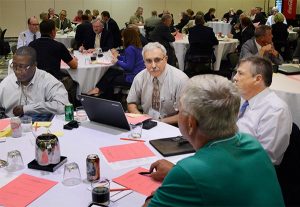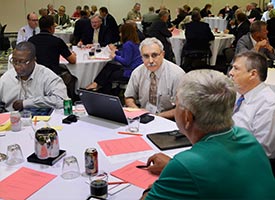By Roger Drinnon
ST. LOUIS — District presidents, district business managers and a lay representative of each district’s board of directors met here Sept. 22 for the 2015 LCMS Fiscal Conference, which assessed priority issues affecting the future of the Synod.
The event, which was sponsored by the LCMS Board of Directors, followed immediately after the regular meeting of the LCMS Council of Presidents (COP), which took place Sept. 19-22. (See related story.)

Conference participants heard from representatives of two ministries of the LCMS Office of National Mission (ONM) — Stewardship, and Witness and Outreach — while examining fiscal issues affecting both.
Prior to the presentations on those ministries, Mark Hofman, LCMS executive director of Mission Advancement, posed questions about how the Synod, its districts, congregations and individuals might approach stewardship matters by “working collaboratively, communicating earlier and by recognizing that God already provides everything we need.”
“I believe such an approach opens new opportunities and stimulates some potentially interesting dialogue,” said Hofman.
The Rev. Heath Curtis, coordinator for the ONM’s Stewardship Ministry, addressed the changing demographics of the Synod and factors behind the decline in membership over the past two decades. His presentation included information from two research reports: “Generational Generosity, A Report to the LCMS,” by Dr. Ryan MacPherson, and “The LCMS in the Face of Demographic and Social Change,” by Dr. George Hawley.
“For the past decade [and for 18 of the past 20 years], the Synod has been losing membership every year. Of course, there are many factors that go into a church’s rate of increase or decrease,” said Curtis. “Our researchers address [those factors] and many others, but both researchers conclude that the overwhelming reason for our decline is a lack of natural growth … children who are never born cannot go out and tell the Good News about Jesus [to others].”
The Rev. Mark Wood, the ONM’s director of Witness and Outreach Ministry and who also leads the Synod’s Revitalization Initiative, spoke about upcoming resources for congregations to evaluate their ministries and refocus on mission.
“We are at a juncture as a church body at which we must decide whether we will either remain a homogeneous church and ride out an inevitable decline or reach out to a growing population of people who are different than the majority of us,” said Wood. “Since our Lord has called us to take the Gospel beyond the current and usual limits of our congregations, we are actually faced with a decision of faithfulness. The resources being developed for the [revitalization initiative] are designed to assist congregations with the faithful response of inviting, welcoming and receiving people who are outside of and disconnected from the Church.”
After hearing each presentation, conference participants engaged in small-group table discussions to brainstorm ideas to address priority stewardship and related issues. The Synod’s Office of National Mission, Board of Directors and Office of the President will all be involved in reviewing and putting into action appropriate suggestions. The information from the table discussions will be shared with all the conference participants, once compiled.
“It was as much information-gathering as information sharing. I really appreciate the work being done with evangelism, witness and outreach, as well as stewardship,” said the Rev. Richard Snow, who attended the conference as the Nebraska District president. “The Body of Christ and our own LCMS have much to offer a world darkened by sin and increasingly opposed to the truth of God’s Word. Together, we all have the Good News to proclaim in each of our vocations.”
Other LCMS district presidents who participated also said they appreciated the opportunity.
“The Synod leadership gave a realistic but also a hopeful look at our likely future as congregations and collectively as a Synod,” said the Rev. Dan Gilbert, president of the Northern Illinois District. “They also gave us a preview of what looks to be excellent material coming out of the Office of National Mission for our congregations to use in serving their communities in the name of Jesus.”
“I appreciated the willingness of those leading the Fiscal Conference to take a listening posture,” said the Rev. Dr. Dean Nadasdy, president of the Minnesota South District. “One sensed that they sincerely wanted to tap the minds and hearts of those present, seeking pathways to stronger partnerships among congregations, districts and the Synod in the stewardship of our gifts – I’m eager to see what was learned.
The costs of bringing district business managers and lay representatives from each district board to St. Louis were paid for with a “Wise Stewardship/Joyful Giving” grant from Thrivent Financial.
Roger Drinnon (roger.drinnon@lcms.org) is manager of Editorial Services for LCMS Communications.
Posted Oct. 21, 2015 / Updated Oct. 22, 2015
